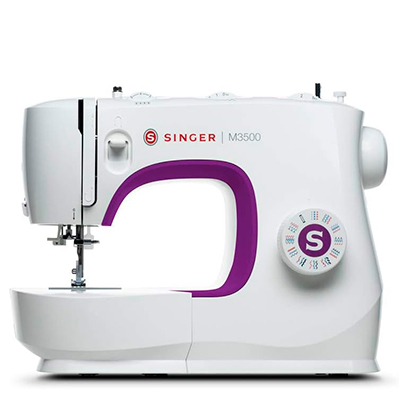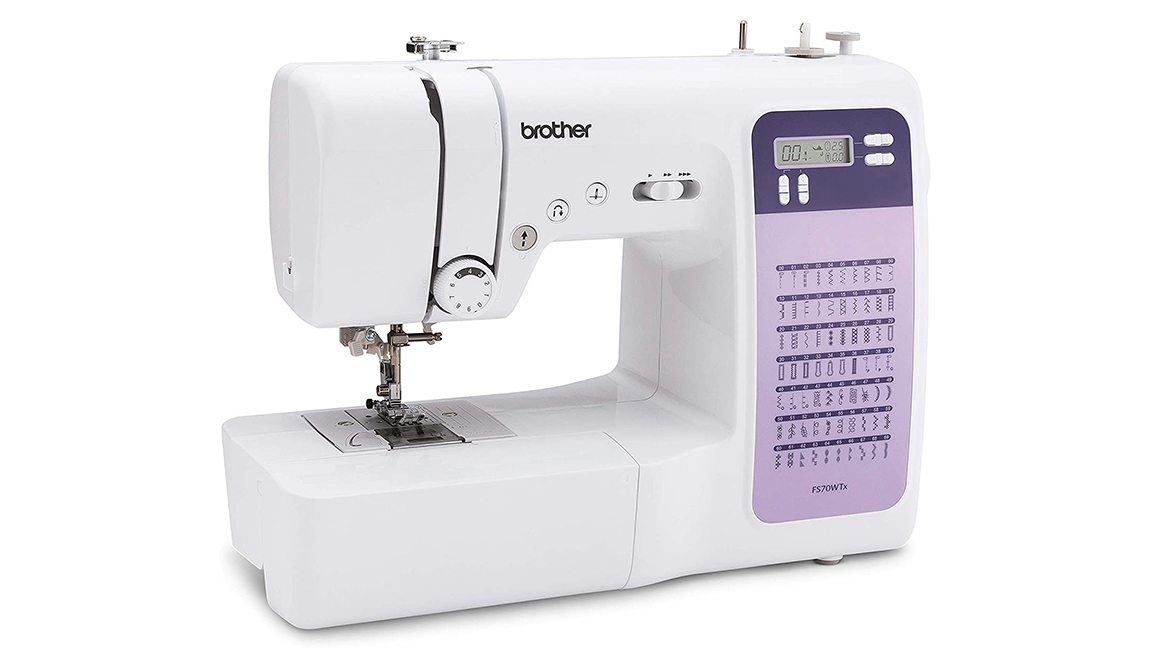The best sewing machines
As a sewer, I've selected the best sewing machines for quilting, making clothes or simply for anyone looking for a new hobby.

The list in brief ↴
1. Best overall: Singer Heavy Duty 4423
2. Best price: Singer M3500
3. Computerised: Brother XR9550
4. Best for quilting: Janome America M7
5. Best intermediate: Brother CS7000X
6. Best large: Brother NV1800Q
FAQs
How to choose
How we test
When choosing from the best sewing machine for you, there are several things to considering, including its functions and features, built quality and, of course, your budget. If you're an experienced sewer a more expensive machine is best as it will last many years. In my list I've chosen my favourite sewing machines, including the best sewing machine for clothes and the best sewing machine for beginners.
A good sewing machine is a much-needed companion to the best Cricut machines, which can allow you to cut your cloth accurately and speedily and then begin stitching. If you're new to sewing, see our guide to the best sewing machines for beginners. If you're specialising, we also have a guide to the best sewing machines for quilting.
The quick list

+ Plenty of built-in stitches
+ Fast and robust
We rate this mechanical option as the best option for a beginner sewing machine that will last, and it can handle denim and other tough fabrics with ease. We found it to be easy to use and super fast, although the speed can make it a little noisy.
Read more below

+ Great value for beginners
+ Compact design
We found this compact sewing machine super easy to use. It comes with enough pre-loaded stitches for most basic jobs and is powerful enough to be used on stiff fabrics, such as denim and wool, although it isn't ideal for delicate fabric like silk. With an automatic needle threader and one-step buttonhole function, it offers plenty for the beginner to enjoy.
Read more below

+ Can handle quilting
+ Comes with extender table
For under $300, this computerised sewing machine represents excellent value (XR9550 is available in the US; in the UK, consider the FS130QC). You get 165 built-in stitches, an easy-to-use LCD display and an extension table for quilting. We found the design approachable with some higher-end functions, but it's not great for embroidery.
Read more below
The best sewing machines in full
Why you can trust Creative Bloq
The best sewing machine overall


Specifications
Reasons to buy
Reasons to avoid
For the price, the Singer 4432 is at the top-end for a mechanical sewing machine but not without good reason. With an integrated motor 60% stronger than standard sewing machines, It is a heavy-duty sewing machine that can tackle a wide range of fabrics, including stretch and denim. I feel this is one of the best sewing machines for everyday use, which makes it one of the best sewing machines for home use.
In our Singer 4423 review, we noted that this sewing machine has over 32 stitch options, including a one-step buttonhole function. We found it to be very robust and also fast. The metal frame has rigid support to hold all the mechanisms in perfect alignment for skip-free sewing and it includes an extra high sewing speed. You’ll be stitching up a new pair of jeans in a flash.
The best cheap sewing machine


02. Singer M3500
Our expert review:
Specifications
Reasons to buy
Reasons to avoid
The Singer M3500 is the best sewing machine for new sewers in our opinion as it's easy to use, comes with enough pre-loaded stitches for most basic jobs and is a neat and compact design. When you're starting out you'll likely head to a friend's house, visit a relative or attend classes, so a small sewing machine is ideal.
This sewing machine features 110 stitch applications, enough for most projects. We found that it could handle basic and decorative sewing and had enough power for use with stiff fabrics, such as denim and wool (it's less ideal for delicate fabric, such as silk.)
As a first-time sewing machine it's an excellent choice, and comes with some of the tech you'll come to live with, including an automatic needle threader, a front-loading bobbin for ease and a one-step buttonhole function. If you're looking for a first-time sewing machine that will last and not break the bank, it's a fun, stylish option.
The best-value computerised sewing machine


03. Brother XR9550
Our expert review:
Specifications
Reasons to buy
Reasons to avoid
The Brother XR9550 is an excellent entry-level and affordable sewing machine that can be used for both sewing tasks and quilting projects. For a sewing machine under $300 / £300 this Brother represents excellent value.
For your money you get a computerised sewing machine with 165 built-in stitches, an easy to use LCD display and an extra wide extension table for quilting. This is one of Brother's most popular machines and combines an approachable design and use (an automatic needle threader) with some higher-end functions – such as all those pre-loaded stitches and LCD screen.
The only downside I can see is it's not a great embroidery machine, as some of the alphabet stitches are a little small. But you can't have everything. The Brother XR9550 model is available in the US. In the UK, look for the Brother HC1850 or FS130QC.
The best sewing machine for quilting

Specifications
Reasons to buy
Reasons to avoid
The Janome America M7 (previously known as the Janome Continental M7 Professional) is expensive but it's also a beautifully designed and well-built sewing machine that will last a long, long time. It's been designed for quilters with height to see the material clearly, and a large extension table enables you to work on big projects with ease. The Janome America M7 has plenty of customisable stitches (400) and alphabets (5) to give any quilter options.
In our Janome Continental M7 Professional review (the Janome America M7 is a newer update to this), our tester discovered a machine that can be turned to near enough any sewing project. It's a large and complex computerised machine but comes with an LCD screen and menu system that is approachable and easy to use. The free QR code-enabled app takes you directly to tutorials, too.
This is an expensive sewing machine but it can do everything and anything, meaning it will last you through your sewing journey. The real ace in Janome's deck is the Janome America M7 is so easy to use; you can be up and running in minutes and the app and LCD screen and computer inside enables a constant and elegant learning curve. If you can afford it, and if you're quilting every day professionally, then this is one of the best sewing machines on the market.
The best intermediate sewing machine

05. Brother CS7000X
Specifications
Reasons to buy
Reasons to avoid
If you are looking for a machine that does it all at an affordable price, the Brother CS7000X (known as the Brother FS70WTX in the UK) has you covered. With 70 in-built stitches and seven feet included, the model has everything you need for dressmaking, quilting, embroidery and home furnishings projects.
The Brother CS7000X also a great choice for anyone who wants to do free motion embroidery, as it comes with an extra wide table and one of the included feet is a free motion embroidery foot.
This feature packed sewing machine has time saving elements too, such as a needle threader and a quick set drop-in bobbin and bobbin winder. The inclusion of an LED light, which won’t need replacing, avoids thread discolouration from a bulb. The Brother CS7000X is a great machine whether you are new to sewing or a more advanced sewer.
The best larger sewing machine

Specifications
Reasons to buy
Reasons to avoid
The Brother Innovis NV1800Q can do just about everything you'd ask of it, and comes with some eye-catching features you'd not usually find on a machine in this price range ($1,799 / £1,499), such as sideways sewing.
In our Brother Innovis NV1800Q review, our writer loved the sideways sewing feature that enables you to stitch continuously without needing to raise the sewing foot and move your material 90 degrees. Obviously, this is great for quilting large, heavy material but also handy for sewing patches and badges.
This is a sewing machine crammed with features and an accessible LCD touchscreen to help you get around. It's also a machine that can grow with you, its My Custom Stitch function enables you to design and program your own stitches.
If you're not a quilter then you may find much of what this machine does surplus, and you could also find it too large and heavy for everyday clothes alterations. But if you do quilt and sew large projects, you'll find the Brother Innovis NV1800Q excellent value for money.
If you're in the US the Brother SE1900 is a similarly specced and excellent machine that offers 240 built-in stitches, 11 fonts and is a good all-rounder for sewing, quilting and embroidery.
FAQs
Do I need to spend a lot of money on a sewing machine?
Someone sewing once in a while doesn’t need to be spending as much on a sewing machine as the person sewing every day. Establish your needs and budget and let our guide to the best sewing machines help you find the best machine in your price range.
How long does a sewing machine last?
If you buy the right machine for your needs, treat it well and get it serviced, your machine will serve you for a very long time. Most brands offer an after-sales service which you can call for replacement parts and problem shooting.
How many stitch options does my sewing machine need?
For clothes, really not very many. A straight stitch, buttonhole and a zigzag stitch will get you through most projects. However, if you are going to be sewing lots of sportswear and t-shirts that require a professional hemmed finish, you'll need a coverstitch machine and/or an overlocker/serge sewing machine. An overlocker (or serger) finishes the edges of fabric with an overlocking stitch whilst also cutting off the seam allowance as it sews.
Where can I buy a sewing machine?
You can buy sewing machines from Amazon and leading stores in your country, for example John Lewis in the UK and Walmart in the US. We would also advise you find your local Brother or Janome dealer as they can offer good advice and repairs.
How to choose the best sewing machine for you
Consider what you need the sewing machine to do. There’s no point splashing out on a computerised machine with a hundred embroidery stitch options if you are predominantly going to sew curtains.
If you want to sew with heavyweight fabrics on a regular basis, a £100 machine just isn’t going to cut it. And if you’re going to sew sports and swimwear, you’ll need a machine with suitable stitches for dealing with stretch fabrics.
How we chose the best sewing machines
If you'd like to read more about how our reviewers work and test each sewing machine then take look at our How we test craft and sewing machines explainer, where we outline the process. Generally our reviewers will use a sewing machine for up to four weeks and create projects to test the key features.
Daily design news, reviews, how-tos and more, as picked by the editors.

Michelle is a sewing teacher, writer and maker based in the Peak District. As a dressmaking tutor and freelance craft feature writer Michelle regularly writes for Love Sewing magazine as well as Woman's Weekly & Woman & Home. As a sewing tutor and avid dressmaker she has extensive knowledge of sewing machines and overlockers, and the know-how of how to match different dressmakers' needs and budgets to the right machine for them.
- Ian DeanEditor, Digital Arts & 3D
